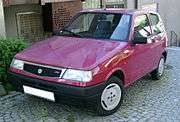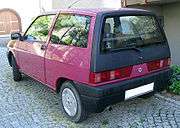Autobianchi Y10
| Autobianchi Y10 / Lancia Y10 | |
|---|---|
 Autobianchi Y10 | |
| Overview | |
| Manufacturer |
Autobianchi Lancia |
| Also called | Lancia Y10 |
| Production | 1985–1995 |
| Assembly |
Desio, Milan, Italy (1985–1992) Arese, Milan, Italy (1992–1995) Pomigliano d'Arco, Italy (1987–1995)[1] Mirafiori, Turin, Italy[2] |
| Body and chassis | |
| Class | City car (A) |
| Body style | 3-door hatchback |
| Layout | FF layout or 4WD |
| Related |
Fiat Panda Fiat Cinquecento |
| Powertrain | |
| Engine | |
| Transmission | 5 speed manual or CVT |
| Dimensions | |
| Wheelbase | 2,159 mm (85.0 in) |
| Length | 3,390 mm (133 in) |
| Width | 1,510 mm (59 in) |
| Height | 1,420 mm (56 in) |
| Curb weight | 780 kg (1,720 lb) |
| Chronology | |
| Predecessor | Autobianchi A112 |
| Successor | Lancia Y |
The Autobianchi Y10 is a 'designer' city car and economy car manufactured from 1985 to 1995 and marketed under the Lancia brand in most export markets (as Lancia Y10). The car was manufactured at Fiat´s Autobianchi plant in Desio, Milan until 1992 and after that in Arese, near Alfa Romeo's plants. It offered a very high level of trim for its market segment. The Y10 featured a new rear rigid axle suspension design (called Omega axle) that was subsequently fitted to the facelifted Fiat Panda. Despite its short length, the Y10 boasted a drag coefficient of just 0.31.
It sold rather well, for its unique style, luxurious trim and the continuously variable transmission that equipped certain versions. Its excellent aerodynamics, characterized by very clean lines and a Kammback, also provided great fuel economy. Sales in the United Kingdom were not very strong, and it was withdrawn from sale there in late 1991. This was more than two years before Lancia withdrew from Britain, and all other RHD markets.
Specification
The Autobianchi Y10 made its official debut at the Geneva Motor Show in March 1985[3] designed to replace the fifteen-year-old A112. It lost out for the title of European Car of the Year for 1986 by the Ford/Merkur Scorpio.[4]
Design
The A112 remained on sale, alongside the Y10, almost to the end of 1986. The Y10 was sold under the Autobianchi marque in Italy, France and Japan,[5] and in most other market was sold under the Lancia marque.
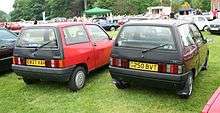
The Y10's most important design innovation was the vertical tail cut-off, characterized by the tailgate painted in black satin, regardless of the color chosen for the body. The shape of the small body, notably wedge shaped, is very aerodynamic (CX 0.31),[3] thanks to the hood which is inclined towards the curved windscreen and side windows that were mounted flush with the bodywork, the absence of drip rails, the recessed door handles and roof tapering slightly toward the back.
All these features were unique for a small car in 1985 and were developed by the Fiat Style Centre, at that time led by Ing. Vittorio Ghidella. The definition of the project Y10 took more than 3 years of study. It was necessary that this car had a very specific identity to allow it to be unequivocally placed under the Lancia brand. The appointments were originally entrusted to Pininfarina and Giorgetto Giugiaro as well as the Fiat Style Centre. Hundreds of drawings were executed with sketches and scale models starting as early as 1980. Eventually a design by the Fiat Style Centre was selected and developed that best responded to the theme of a car destined to a particular user, "select and elite", a real flagship miniature desired by women as much as a handbag and identified by the men as their favorite perfume.
The car had rectangular headlights, which, together with a simple and elegant grille defining the shape of the engine hood, giving the front of the car a very "technical" look, totally different from the back end. The windshield, installed with silicone resin instead of a rubber gasket was large, sloped and characterized by a single wiper, a functional and practical solution. The side was kept very clean and is characterized by a belt line from the base of the hood rising gradually as it approaches the lower edge of the tailgate, delimited by the wrap-around taillights. The flanks did not have any pronounced rib, only a very slight pleat, a profile of embellishment and protection.
The Y10 was offered only with a three-door body with relatively large doors, offering easy access even for rear passengers. The tailgate was at a nearly vertical plane, hinged to make it more practical to access the luggage compartment by shifting the point of rotation eleven centimeters towards the center of the roof, allowing an easy opening. The rear lights were of a horizontal layout, similar to the latest A112 with a bumper wrapping around the sides of the car underneath them.[3]
Interior
The interior has carpeting on the floor, standard on all versions, cloth upholstery on the seats and top-range versions featured Alcantara upholstery on the dashboard, seats and door panels, and options such as electric windows, central locking, split rear bench seat, rear window hinged electrically (revolutionary solution at the times), glass sunroof and climate control system with electronic controls and LED display, similar to that already adopted on Fiat Regata.[5]
First series (1985–1988)
The attention and interest shown by the international public at the Geneva Motor Show, Fiat-Lancia Group to give hope that the new Y10 meet the public's taste, but sales of the first month struggle to take off. The real cold shower, which curbs the enthusiasm of the first potential customer lists are Y10, judged too high, evidently people willing to spend more for a little economy car 'most wanted in 1985 are still few. In 1985 Autobianchi-Lancia assembled 63.495 Y10.
The campaign focuses on the vehicle's original philosophy and technical content. Because Y10 is innovative car that offers exceptional performance and a series of new solutions in its class. Thus was born "The city of the future" and, thanks to "Donna Robot" (Woman Robot) that acts as godmother moving with sinuous feminine, the car becomes unmistakable Y10 characterized by its modernity.
All versions come with a five speed gearbox. The Y10 was taken, in the arrangement of the main mechanical parts, most cars of its era: front-wheel drive, front transverse engine, as regards the suspension has a MacPherson strut front and rear rigid axle "omega".[3]
1985
Y10 Fire: Equipped with the new four-cylinder Fire[3] (Fully Integrated Robotized Engine), with displacement of 999 cc and maximum power of 45 hp at 5000 rpm/minute, a very flexible engine, low noise, low-power, allowing it to exceed 145 km/h and accelerate from 0 to 100 km/h in 16 seconds.[6]
Y10 Touring: It is powered by a Brazilian-built motor of 1049 cc, which was also used in the Fiat Uno.[7] This has a maximum power of 56 hp at 5850 r/min and maximum torque of 81.4 N m at 3000 r/min, and is developed from Fiats Lampredi-designed four-cylinder that originally equipped the Fiat 127. The Touring is externally identical to the Y10 Fire, aside from the trunk badging, while on the carrier can be seen the Alcantara in place of the fabric coverings. The Touring is quite lively, with a maximum speed of 155 km/h and acceleration from 0 to 100 km/h in 14.5 seconds.[8]
Y10 Turbo: The turbo has the same basic Brazilian engine as the Touring.[7] Here, however, it is equipped with an IHI turbocharger with intercooler,[9] with a maximum power of 85 PS at 5750 r/min and maximum torque of 122.6 Nm at 2750 revs/minute. Compared to the naturally aspirated 1050 in the Touring, is distinguished by sodium filled exhaust valves,[3] the segments special, the collectors high resistance, the electric fuel pump and electronic ignition "Digiplex". It boasts of a supercharging system from "Formula 1" in miniature with intercooler, bypass valve and thermostatic valve. This version has a top speed of 180 km/h and accelerates from 0 to 100 km/h in 9.5 seconds; is externally recognizable by the presence of a red piping on the bumpers, for the adhesive band at the base of the side with the writing Turbo, the tailpipe in polished metal and larger bumpers themselves, specific design and larger than her sisters "quiet" inside you may notice an unusual wheel design from sportier seats as well as from molding and wrapping the analog instruments have more complete series, but with extra arricchibile with Check Control instrumentation or "solid state".
1986
In 1986 new versions were added and some of them were cheaper. The range includes models from Fire, Fire LX, Touring and Turbo. All had the required height adjustable steering wheel. The sales finally take off, despite the disappointment of the earliest examples of buyers, not at all happy to see prices decline significantly a few months after its debut. At the end of 1986 a 4WD version was introduced and the total production of all models in 1986 was of 80,403.
Y10 Fire: The new entry-level version, the Fire, is now standard equipment in most meager, however, to which corresponds a lower price, estimated at one million lire; outside this version is recognizable by the front grill looks very poor, with i.e. a frame in matt black and black grille (in contrast to Fire '85 that had a polished stainless steel frame and a grid, the same for all versions, with baffature silver), the taillights simplified and asymmetrical, with only a reversing light to the right and only one headlight on the left rear fog light. Were kept inside the cloth upholstery and introduces a new dashboard, also adequately depleted by the absence of doors on compartments and drawers.
Y10 Fire LX: Between the Fire and the Touring is now brought a new version, the Fire LX.[3] In essence, this is the '85 version of Fire, and differs from the new basic version, as well as for the plate back to the bridge, looking richer and here with the doors self-closing drawers and compartments, upholstered in Alcantara as well for the presence of electric windows, central locking and overhead digital clock Borletti Vegliaflesh and reading lights, all part of the standard.
Y10 Touring: The Touring version remains unchanged in price but offers more equipment that includes front electric windows, central locking and digital clock. The engine the same too, the classic 1049 cc aspirated.
Y10 Turbo: The Y10 Turbo (similar to the Touring) now offers standard front electric windows, central locking and internal digital clock. They also improve the finish than the previous models with plastic assembled products better.
Y10 4WD: At the end of that year, in October 1986, the range was extended further, it debuted the Y10 4WD, four-wheel drive version (derived from the same traction system of Panda 4x4 and produced in joint venture with Steyr[3]), equipped with Fire from 999 cc, with power increased to reach 50 hp (37 kW) at 5500 rpm/minutes. It can safely be called a true SUV ahead of its time for their design, finishes and contents at a mechanical level. The all-wheel drive can be inserted via a button on the dash, and a complex and modern electro-pneumatic system that allows, four-wheel drive off, leaving firm transmission shaft and rear axle shafts, the pull is inserted by pressing the button, the engine is running and the car is stopped or at least at speeds below 55 km/h (34 mph), where the traction was inserted over this speed, the wheel would fit only slowing below 55 km/h (34 mph) and also to prevent accumulation of ice, mud or snow clogging your system actuators of the transmission control, it is automatically inserted by turning off the engine. It is easy to recognize the 4WD thanks to the large lateral fascia of plastic material, the wheel rims of specific design without any hub cap and the front and rear splash guard; to distinguish it further we think the identification written on the tailgate, on the side shields and the splash guard as standard. Inside were adopted covering novel and the steering wheel, drawing more exclusive, the Turbo. It is part of the standard package right external mirror, but the optional Headlamp cleaning system, instrumentation and Control System with tachometer, sunroof, electric windows, central locking, split rear seat and steering wheel adjustable for height. The Y10 4WD has a top speed of 145 km/h (90 mph) and accelerates from 0 to 100 km/h (62 mph) in 17.4 seconds.
It is interesting to see how, with a range of versions available in the catalog and the possibility of almost infinite customization possible, the Y10 go looking for customers as diverse and varied as possible.
1987–1988
In the period 1987–88 the small Autobianchi becomes increasingly a mature product, with a precise position on the market, coveted by a clientele varied and very different instances. It now counts the expected success, but otherwise makes itself heard at events so far unusual in the automotive world: the presentation of the "special series" particularly enhanced and exclusive versions, with features and details in their own right, that is not available on cars common, once again to emphasize the variety of users Y10. Twenty years later, special versions related to a brand, not necessarily in the automotive field, are visible to all and are now part, on a permanent basis, the vast majority of lists: in those years a new concept even diffuse Y10 in order to offer the car: a real object "trendy" to limit the "snob", linked to the lifestyle of the period, to be shown as a real "status symbol" or as an object belonging to a group. In 1987 was assembled 109.708 Y10 for a total of 254.000 vehicles produced from 1985.
Alongside the classic versions of the list are also run special versions.
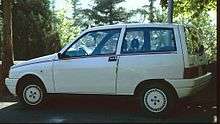
Y10 Fila: The first special version to debut in February 1987, is the Y10 Fila, a model aimed primarily at young and dynamic company Biella signed homonym of sports and leisure. Mechanically derived from Y10 Fire (range 1986),[3] which retains the standard accessories, it is very easy to recognize because they are fully painted in white: not only the body but also the tailgate, bumpers, grille front and wheel trims. To break the monotony we think the adhesive strips in black and blue, running along the beltline, culminating towards the door, with the famous mark; in the seats and door panels were covered with blue fabric, and Fila logo was placed on the backs of front seats. The success of this first special version, especially by young award-winning, not long in coming to the point that, in March 1988, it is supported by the second version, called Fila 2: the body is now painted black, this time excluding hub caps, bumpers and front grille, the strip that runs along the side wall is white and red this time, as well as the interior is the coloring of the fabric to be different, no longer blue but red.
Y10 Martini: The Y10 Martini a few months following the first edition of Fila, and arrives in dealerships in June 1987.[3] Made to celebrate the sporting association with Martini & Rossi, which for decades collecting the Lancia successes in the racing world with his incomparable Delta, the Y10 Martini comes from Turbo and available, even in this case, in white only, also used for wheel covers (available as an optional alloy wheels) while the bumpers are those, wrap around and lowered, the Turbo, unpainted. The side is covered by a strip with the colors of the racing team winning Martini colors used for the seat fabric and door panels.
Y10 Missoni: With the arrival of autumn, in October 1987, comes the Y10 Missoni, derived from the Fire LX and signed by the famous fashion designer Ottavio Missoni (which will appear in a television spot next to his creation), he has chosen for a body exclusive and unique Memphis Blue metallic (black door), with matching interior fabrics, made of hazelnut Alcantara dashboard and door panels, seats while adopting a fabric "Missonato" velvet stripes, the carpet is coordinated with the exterior color, and to make recognizable this version, in the final part of the side, halfway between the rib and the rear window, is applied an adhesive of the mark Missoni.[3]
Second series (1989–1992)
In February 1989, the Autobianchi Y10 presents the second series, characterized by slight but significant aesthetic touches and the interior, and affected by important changes in engines: As a result, the new range was born: "The privilege to evolve, remaining self- same "as he plays his TV advertising launch.[5]
All models now have a new design wheel trims (except 4WD), white front indicators, rear lights (symmetrical and now the same for all versions), made in two colors: double reverse light-colored smoke, dual projector fog red, side lights and stop (double stranded) in red and blinkers smoked. Amber indicators disappear and with them a fashion hitherto held sway in the automotive field.
The Fire now has a new radiator grille, the look is not the poorest, the outer frame adorned with stainless steel since 1986 had been a legacy of top-range versions, but with a single colored grid, that is devoid of chrome baffature. Inside was changed back in the back seat, to the benefit of the load capacity of the trunk, making it more vertical and less padded, have changed the door panels, which now include the buttons at the bottom of the front electric windows (optional on Fire) and prepared for the speakers, but the bridge remains the most economical type, ie without the doors of compartments and drawers. Are also new fabric upholstery.
All new models have the instruments with new graphics,[5] which is also much less "80" and, except Fire, steering wheel adjustable for height. The air conditioning now standard also provides internal recirculation function manually or, on request, a new digital climate control system, this time with electronic temperature control with display and "auto" for the maintenance of constant temperature.
The previous range including the Fire, the Fire LX, Touring, the Turbo and the special series, survives only version of Fire while all the other versions out of production and with them also the engine of 1050 cc, both in versions aspirated (Touring ) is in the turbocharged (Turbo). This engine is now replaced by the Fire of 1108 cm ³, which debuted in 1988 with the launch of the Fiat Tipo and that, in the case of Y10, is equipped with electronic fuel injection Single Point; characterized by a maximum power of 56 hp at 5500 revolutions / minute and a maximum torque of 88 Nm @ 3000 rpm/min, i.e. mans unpublished Fire LX, which reaches 156 km/h and accelerates from 0 to 100 km/h in 13.9 seconds.
The Y10 was not a strong seller on the British market, where the Ford Fiesta and Austin Metro were the established market leaders and the leading imported small cars were the Peugeot 205, Fiat Uno, Volkswagen Polo and Nissan Micra. It was withdrawn from sale on the British market at the end of 1991, by which time Lancia sales were in steep decline, not helped by the recession. Just over two years later Lancia withdrew from Britain completely.
1989 and introduction of electronic injection engine
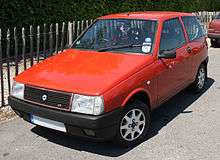
Y10 GT i.e.: If the disappearance of the engine 1050 turbo, for reasons of approval pollution in some European countries (Switzerland, Austria and Germany) has caused many regrets, the new naturally aspirated engine of 1301 cc, fuel injected electronic Multi Point, Brazilian production and derived from previous 1050, is worthy substitute, and is able to pull a maximum power of 78 HP at 5750 rpm/minute and a maximum torque of 100 Nm at 3250 rpm. This equips the new 1300 GT i.e. version, created to replace the Turbo, capable of reaching 178 km/h and accelerate from 0 to 100 km/h in 11.5 seconds. It also promised more comfort and a smoother drive than the raucous turbo version. With the discontinuation of the Turbo performance was somewhat adversely affected, but all in all the GT is much more "usable" becoming more of an "all-rounder" GT. The GT i.e. is characterized by red border that frames the front grill, by an adhesive strip, with the mark of identification, which runs through the lower edge of the side, by original hub caps (optional alloy wheels) and chrome tailpipe, are internally presents itself like its LX i.e., with different types of coating. The instrumentation as well as for the previous Turbo, more complete and intonation sporty.
Y10 Fire LX i.e. (and Selectronic version): The new Y10 Fire LX i.e. is recognized externally for the lower bumper painted in body color, the adhesive strip, with the mark of identification, which runs through the lower edge of the side and the chrome tailpipe, internally, cloth seats, or on request, upholstery in Alcantara. Dashboard and door panels are upholstered in Alcantara as standard.
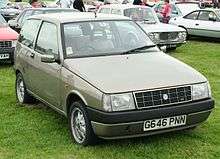
In December 1989, confirming its leadership position in technological level reached by small Autobianchi, debuts Y10 Selectronic automatic transmission version with ECVT: Electronic Continuously Variable Transmission. Moved by Fire engine 1,100 Single Point Injection of LX i.e., the Selectronic automatic transmission has a continuously variable relationships with electromagnetic clutch (not hydraulic like the Fiat Uno Selecta), arising as construction, i.e. the LX, the Selectronic reaches a top speed of 150 km/h and accelerates from 0 to 100 km/h in 15 seconds. The CVT transmission was produced by Japanese Fuji and was the same of the Subaru Justy.[3]
Y10 4WD i.e.: The 4WD, all wheel drive can be inserted, changed its name and becoming 4WD i.e. engine changes and, from 1000 to the Fire 1100 Fire electronic ignition Single Point of LX i.e. With the new engine, the 4WD Reaches 151 km / h and Accelerates from 0 to 100 km / h in 15 seconds. The 4WD i.e. Finally, the external appearance Remains Unchanged, massive retaining the lateral end of the previous version, and the rims of specific design.
1990–1992
A few months later, in March 1990, the range of Y10 catalysed models was announced.[3] For each existing version there is a corresponding model with a catalytic converter, with the exception of Fire carburettor, which remains firmly in the top of the preferences of the public, for its economy.
The engine 1,100, now called "Europa" in accordance with EU Directives, in an ecological version reaches the maximum power of 50 hp (37 kW), sufficient to allow the LX i.e. touching 150 km/h, the Selectronic to reach 145 km / h and i 4WD to touch the 142 km/h. The catalyzed version of the GT i.e. now has an engine of 1297 cc, with a maximum power of 72 hp (53 kW), which allows a top speed of 172 km/h.
Y10 Mia: Stands alongside the versions Fire and LX i.e., by using such engines, 1,000 and 1,100 Fire carburettor Europe. The Y10 Mia introduced the ability to customize the color scheme for the dashboard, door panels and upholstery with a choice of different shades of Alcantara (ice, camel beige, turquoise and red carmine). The Mia almost 40% of total orders of production 1991–92.
Y10 Ego: Two months later, in September 1991, the Ego is born, i.e. LX version based on the Fire catalyzed, it is only available with Black Mica body color (including the tailgate), was completely covered in saddle leather "Poltrona Frau" hue "Bulgarian Red" (as well as the dashboard, gear lever, door panels and steering wheel ), has no foam and upholstered front headrests and improved tires.
Y10 Avenue: In early 1992, on the success of the special version of "Mia", makes its way into dealerships Y10 Avenue, has the tailgate colour coordinated with the body. The Avenue could also be ordered in preparation Selectronic automatic transmission.
Y10 Marrazzi Certa: Derived from Avenue the "Y10 Certa" was prepared by Carrozzeria Marazzi and presented at the 1992 Turin Motor Show. Now dubbed by the press as "utilitarian abduction prevention", the car had been designed to offer greater resistance to the attempts of aggression, reinforced the structure of the doors, locks and bar-proof glass. Which option was also available a little safe in the cockpit, for the transport of any objects prezioni. Designed for customers who typically feminine, at the time of launch it had planned annual production limited to 300 copies, priced at 24 million Lira[10]
Third series (1992–1995)
In 1992 the Y10 underwent a facelift, with changes to the interior and exterior.[5] The front end receives a new grille more compact but also more in keeping with the style of the latest Lancia vehicles, the headlights are smaller and longer while the bumpers front have a new design. The distinctive black rear design is now partially body coloured, and new taillights identify the new model.
From 1985 to 1992 Autobianchi-Lancia assembly over 850.000 Y10 models.[3]
|
References
- ↑ "Fiat di Pomigliano: riapre la fabbrica, ma a ottobre addio all'Alfa". metropolisweb.it (in Italian). Retrieved 2011-09-04.
- ↑ "Cassa integrazione per Fiat". Archiviostorico.corriere.it. Retrieved 2016-01-21.
- 1 2 3 4 5 6 7 8 9 10 11 12 13 14 http://www.omniauto.it/magazine/992/autobianchi-y10 Autobianchi Y10 Story
- ↑ "Previous winners" (in Spanish). Car of the year. Archived from the original on 14 September 2010. Retrieved 2010-09-20.
- 1 2 3 4 5 http://www.y10club.it/Y10CLUB/Y10/Y10.htm Story, Design and Specification
- ↑ "Y10 Fire specification". Y10.altervista.org. Retrieved 2012-06-08.
- 1 2 Bernardet, Alain (April 1985). "Salon de Genève" [The Geneva Show]. Echappement (in French). Paris, France: Michael Hommell (198): 47.
- ↑ "Y10 Touring specification". Y10.altervista.org. Retrieved 2012-06-08.
- ↑ "Y10 Turbo specification". Y10.altervista.org. Retrieved 2012-06-08.
- ↑ "Tante novità per tentare "l'altra metà del mercato"". Archiviostorico.corriere.it. 2009-12-24. Retrieved 2012-06-08.
External links
| Wikimedia Commons has media related to Autobianchi Y10. |
| Wikimedia Commons has media related to Lancia Y10. |
| « previous — Lancia car timeline, 1980s–present | |||||||||||||||||||||||||||||||||||||
|---|---|---|---|---|---|---|---|---|---|---|---|---|---|---|---|---|---|---|---|---|---|---|---|---|---|---|---|---|---|---|---|---|---|---|---|---|---|
| Type | 1980s | 1990s | 2000s | 2010s | |||||||||||||||||||||||||||||||||
| 0 | 1 | 2 | 3 | 4 | 5 | 6 | 7 | 8 | 9 | 0 | 1 | 2 | 3 | 4 | 5 | 6 | 7 | 8 | 9 | 0 | 1 | 2 | 3 | 4 | 5 | 6 | 7 | 8 | 9 | 0 | 1 | 2 | 3 | 4 | 5 | 6 | |
| Supermini | A112 | Y10 | Y | Ypsilon I | Ypsilon II | ||||||||||||||||||||||||||||||||
| Small family car | Delta I | Delta II | Delta III | ||||||||||||||||||||||||||||||||||
| Compact executive car | Beta | Prisma | Dedra | Lybra | |||||||||||||||||||||||||||||||||
| Beta Trevi | |||||||||||||||||||||||||||||||||||||
| Executive car | Gamma | Thema I | Kappa | Thesis | Thema II | ||||||||||||||||||||||||||||||||
| Coupé | Beta Coupé | ||||||||||||||||||||||||||||||||||||
| Gamma Coupé | Kappa Coupé | ||||||||||||||||||||||||||||||||||||
| Cabriolet | Flavia II | ||||||||||||||||||||||||||||||||||||
| Mini MPV | Musa | ||||||||||||||||||||||||||||||||||||
| Large MPV | Zeta | Phedra | Voyager | ||||||||||||||||||||||||||||||||||
| Sports car | Montecarlo | Delta HF 4WD/integrale | |||||||||||||||||||||||||||||||||||
| Rally 037 | Delta S4 | ||||||||||||||||||||||||||||||||||||
| Rally car | Rally 037 | Delta S4 | Delta HF Group A | ||||||||||||||||||||||||||||||||||
| Racing car | Montecarlo Turbo | LC1 | LC2 | ||||||||||||||||||||||||||||||||||
